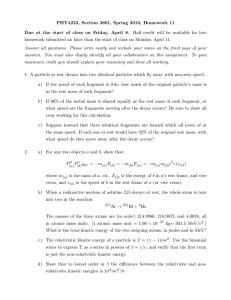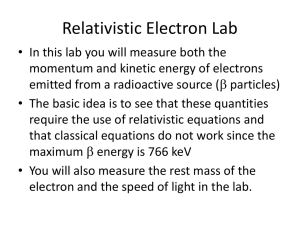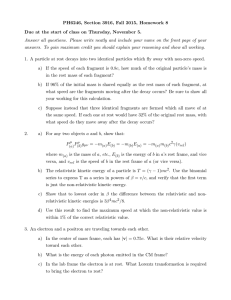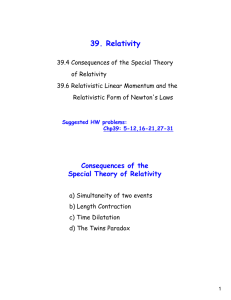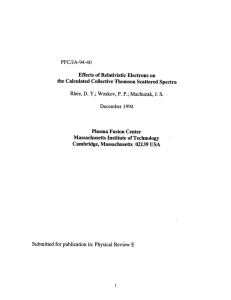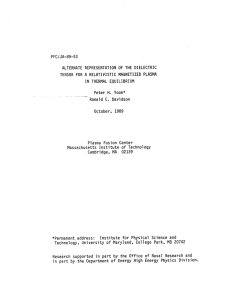Relativistic Modifications to Electron Bernstein Waves
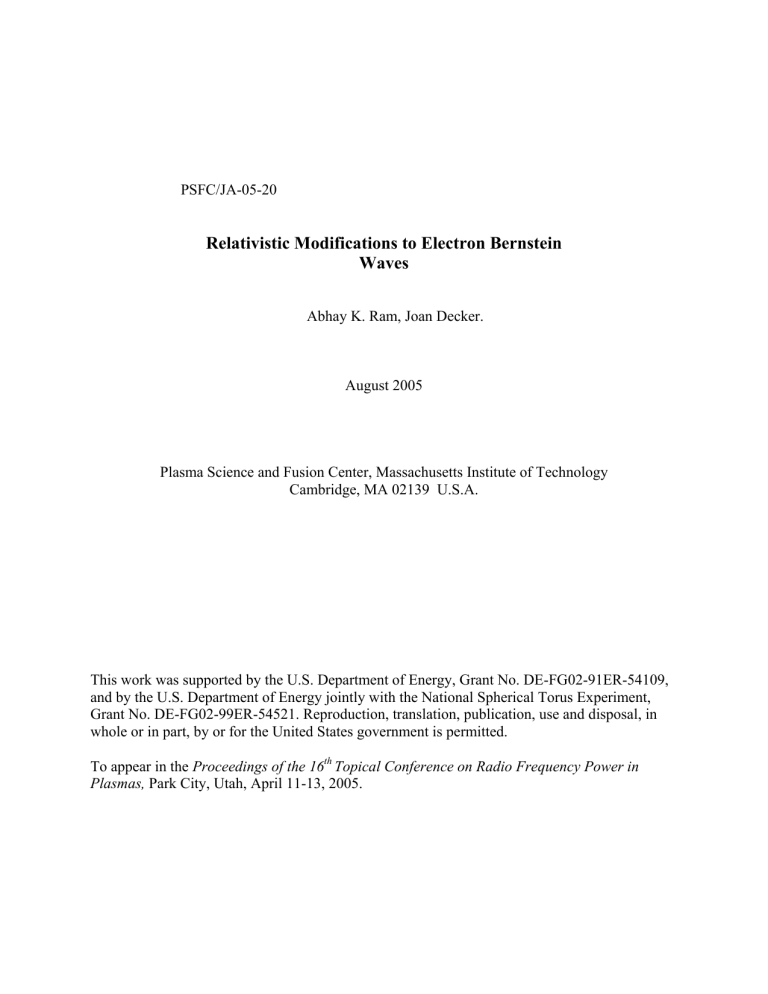
PSFC/JA-05-20
Relativistic Modifications to Electron Bernstein
Waves
Abhay K. Ram, Joan Decker.
August 2005
Plasma Science and Fusion Center, Massachusetts Institute of Technology
Cambridge, MA 02139 U.S.A.
This work was supported by the U.S. Department of Energy, Grant No. DE-FG02-91ER-54109, and by the U.S. Department of Energy jointly with the National Spherical Torus Experiment,
Grant No. DE-FG02-99ER-54521. Reproduction, translation, publication, use and disposal, in whole or in part, by or for the United States government is permitted.
To appear in the Proceedings of the 16 th
Topical Conference on Radio Frequency Power in
Plasmas, Park City, Utah, April 11-13, 2005.
Relativistic Modifications to Electron Bernstein Waves
A. K. Ram and J. Decker
Plasma Science & Fusion Center, M.I.T, Cambridge, MA 02139, U.S.A.
ABSTRACT
In the electron cyclotron range of frequencies (ECRF), electron Bernstein waves
(EBW) offer an attractive means for driving plasma currents in spherical tori (ST) such as NSTX. Previously it has been shown that, for ECRF waves, relativistic effects significantly modify the propagation and damping of the extraordinary and ordinary modes. A fully relativistic dispersion code R2D2 has been developed for studying the relativistic characteristics of all ECRF waves. In this paper we report on initial results obtained from this code which illustrate the relativistic modifications to the propagation and damping of EBWs. We find that even at temperatures relevant to present spherical tori, the relativistic dispersion properties of EBWs are significantly different from their non-relativistic counterpart.
INTRODUCTION
The overdense nature of NSTX-type ST plasmas makes them unsuitable for heating and/or current drive by the conventional ordinary O and extraordinary X modes in the EC range of frequencies. However, EBWs have no density cutoffs and damp strongly on electrons at the fundamental or any harmonic of the Dopplershifted electron cyclotron resonance [1]. Since EBWs cannot propagate in vacuum they are excited, indirectly, by mode conversion of externally launched O mode or
X mode [1].
Away from the mode conversion region, as EBWs propagate into the core of the plasma, the perpendicular (to the magnetic field) wavelength λ
⊥ shortens and becomes comparable to, or less than, the electron Larmor radius ρ e
. Consequently, in contrast to the case of X and O modes, we cannot cannot carry out small ρ e
/λ
⊥ expansions of the dielectric tensor elements for EBWs [2].
RELATIVISTIC DIELECTRIC TENSOR
There are two numerically useful representations for obtaining the relativistic conductivity tensor σ for a relativistic Maxwellian distribution function [3]. The
first form of the conductivity tensor is:
σ =
1
4 π
ω 2 p
ω c c 4 v 4 t K
2
1
à c 2
!
v
Z
0
∞ dξ
K
2
³
R 1 / 2
´
R
T
1
−
K
3
³
R 1 / 2
´
R 3 / 2
T
2
(1) where ω p
, ω c
, v t are the rest mass electron plasma frequency, cyclotron frequency, and the thermal velocity, respectively, K
ν second kind of order ν , and is the modified Bessel function of the
cos ξ − sin ξ 0
T
1
= sin
0
ξ cos
0
ξ 0
1
(2)
k 2
⊥ sin 2 ξ − k 2
⊥ sin ξ (1 − cos ξ ) k
⊥ k k
ξ sin ξ
T
2
= c 2
ω 2 c k 2
⊥ sin ξ (1 − cos ξ ) − k 2
⊥
(1 − cos ξ )
2 k
⊥ k k
ξ (1 − cos ξ ) (3)
R k
=
⊥
à k k c 2 v 2 t
ξ sin ξ
− iξ
ω
ω c
!
2
− k
⊥
Ã
+ 2 k k
⊥
ω k c
ξ (1 − cos ξ ) c
!
2
(1 − cos ξ ) + k 2 k
ξ 2 k 2 k c 2 ξ 2
ω c
2
(4)
For any equilibrium distribution function f
0
( p
⊥
, p k
), which generates no plasma current, the second form of the conductivity tensor is:
σ = − i
2
ω 2 p
ω c
* n = −∞
1 n − ω
Ã
1
κT p
⊥ mγ
!
σ
N f
0
³ p
⊥
, p k
´
+
(5) where
n 2
ζ 2 p
⊥
J 2 n
− i n
ζ p
⊥
J n
J 0 n n
ζ p k
J 2 n
σ
N
= i n
ζ p
⊥
J n
J 0 n p
⊥
J 0 2 n ip k
J n
J 0 n
(6)
ζ = k
⊥ p
⊥ mω c
, ω =
1
ω c
µ n
ζ
ωγ − k p k p
J k
2 n
¶ k m
, ω c
−
= ip k eB
0 m
J n
J 0 n p 2 k p
⊥
Z
J 2 n
∞
, h .....
i =
0 dp
⊥ p
⊥
Z
∞
−∞ dp k
(7)
The use of the perturbed conductivity tensor (1) or (5) in Maxwell’s equations leads to the relativistic dispersion tensor
D
³
~k, ω
´
= c 2
ω 2
~k~k +
Ã
1 − c 2 k 2
!
I +
ω 2
4 πi
σ
ω
(8)
where I is the unit tensor and
~k~k is a dyadic. The dispersion relation for waves in the EC range of frequencies is obtained by setting the determinant det D
´ to zero.
We have developed a code R2D2 that solves for the dispersion characteristics of EC waves using two separate and distinct numerical routines [4]. One routine uses (1) for σ in (8) while the other routine uses (5). Since we are not aware of any similar code in existence, the independent routines allow us to benchmark our own code. For a variety of cases we find that the two routines provide numerically identical results leading us to have confidence in our code.
In the mode conversion region near the edge of NSTX-type plasmas, we find that the results obtained from the relativistic description are the same as those from the non-relativistic description. Thus, the mode conversion formalism developed in [1] is not modified by relativistic effects.
Figures 1a and 1b show the differences between the non-relativistic and relativistic dispersion characteristics of EBWs as a function of temperature. As the figures illustrate, differences start to occur at electron temperatures below 1 keV.
From different numerical results we find that the differences persist but decrease as n k increases. These results signify the relevance of including relativistic effects in the propagation and damping of EBWs. A relativistic ray tracing code based on R2D2 is being developed to further elucidate the differences along ray paths in toroidal plasma equilibria.
Figures 2a and 2b show the right hand circularly polarized and the parallel components of the wave electric field. The differences between the relativistic and non-relativistic results implies that the field polarizations in the quasilinear diffusion operator have to be properly treated. This is important for studying current drive by EBWs [5].
This work is supported by DoE Grant Numbers DE-FG02-91ER-54109 and
DE-FG02-99ER-54521.
REFERENCES
[1] A. K. Ram and S. D. Schultz, Phys. Plasmas 7 , 4084 (2000).
[2] M. Bornatici, R. Cano, O. De Barbieri, and F. Engelmann, Nuclear Fusion 23 ,
1153 (1983), and references therein.
[3] B. A. Trubnikov, in Plasma Physics and the Problem of Controlled Thermonuclear Reactions , edited by M. A. Leontovich (Pergamon Press Inc., New York,
1959) Vol. III, p. 122.
[4] A. K. Ram, J. Decker, and Y. Peysson, accepted for publication in J. Plasma
Physics (2005)
[5] J. Decker et al., presented in this conference.
15 0.4
10
0.3
0.2
5
0.1
0
0 1
T e
(keV)
(a)
2 3
0
0 1
T e
(keV)
2
(b)
3
Figure 1: (a) Real and (b) imaginary part of n
⊥ versus the electron temperature T e
.
Plotted are the relativistic (solid) and the non-relativistic (dashed) characteristics of EBWs for ω p
/ω c
= 6, ω/ω c
= 1 .
9, and n k
= 0 .
2.
1
0.95
0.9
0.85
0.8
0.75
0.08
0.06
0.04
0.02
0.7
0 1
T e
(keV)
2
(a)
3
0
0 1
T e
(keV)
2
(b)
3
Figure 2: (a) The normalized magnitude of the right hand circularly polarized wave electric field (in a plane perpendicular to the magnetic field) and (b) the normalized wave electric field along the magnetic field versus the electron temperature T e
.
Plotted are the relativistic (solid) and the non-relativistic (dashed) characteristics for the same parameters as Fig. 1
